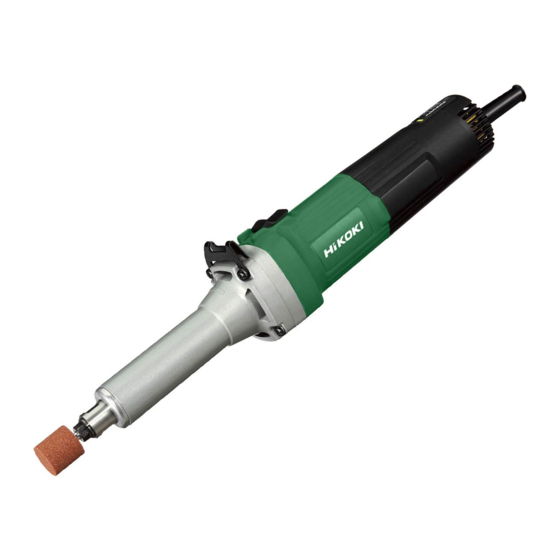HIKOKI GP 5V Manual de instrucciones de manipulación - Página 14
Navegue en línea o descargue pdf Manual de instrucciones de manipulación para Amoladora HIKOKI GP 5V. HIKOKI GP 5V 20 páginas. Electronic hand grinder

5. Adjusting the number of revolution
These models are equipped with an electronic infi nite-
variable-speed drive and can change the number of
revolution according to a use.
If you turn and set the dial scale (Fig. 6) to 6, the number
of revolution increases, and if you turn and set it to 1, the
number of revolution decreases.
Before use, set the number of revolution using the dial. In
so doing, refer to the following table as a rough guide.
Dial
Use
1
Polishing, fi nishing
Removal of paint or
2
coat
3
Removal of rust
4
Removal of burrs
5
Grinding
6
Rough grinding
NOTE: Use caution not to turn the dial scale to any value
below 1 or above 6.
6. Caution when using near welding equipment
When using the grinder in the immediate vicinity of
welding equipment, the rotational speed may become
unstable. Do not use the grinder near welding equipment.
7. Using the side handle (Fig. 3)
Be sure to use the side handle to avoid the risk of severe
electrical shock.
Attach the side handle to the machine as follows.
(1) Loosen the side handle grip and insert the side handle to
the nose bracket part of the machine from the fl ange part
of the side handle sleeve.
(2) Set the side handle to a position that is suited to the
operation and then securely tighten the side handle grip.
Materials to be ground
Mild steel, hard steel,
forged steel
Cast iron
Brass, bronze, aluminium
Ceramic
Synthetic resin
Small-scaled wheels with shaft are prepared for grinding
small surfaces. Their dimensions and shapes are shown in
"OPTIONAL ACCESSORIES".
Since wheel shaft diameter is 3 mm, use the collet chuck
for 3 mm shaft sold separately by your HiKOKI dealer as an
optional accessory.
MAINTENANCE AND INSPECTION
1. Inspecting the wheel
Ensure that the wheel is free of cracks and surface
defects.
2. Inspecting the mounting screws
Regularly inspect all mounting screws and ensure that
they are properly tightened. Should any of the screws be
13
Rotation speed (/min)
GP3V
GP5V
7000
2000
11400
3250
15800
4500
20200
5800
24600
7050
29000
8300
Grain
Grading
WA
60 – 80
C
36
C
36
WA
60 – 80
C
36
HOW TO USE
1. Switching operation
(1) When moving the switch lever to the right (ON side),
power is applied; when moving it to the left (OFF side),
power is switched off .
(2) When fi rst turning on the switch after installing a new
wheel, hold the grinder away from your body to avoid any
danger of a wheel shattering due to an imperfection.
(3) Before starting, test the machine with the wheel pointed
in a safe direction.
2. Precautions on operation
(1) Lightly press the wheel to the material to be ground.
When
grinding
materials,
is necessary. Use a hand grinder with high-speed
revolution, minimizing the pressing force.
CAUTION
When using the tool at any value except the full speed
(Dial scale 6), the motor cannot be suffi ciently cooled due
to the decreased number of revolution.
This could result in the risk of burning and damaging the
motor before an overload protective mechanism starts to
function.
Make sure that you use the tool by lightly applying it to the
surface of material when you use it at any value except
the full speed (Dial scale 6).
(2) Dressing the wheel
After attaching a wheel, correct defl ection of the wheel
center by using a dresser. If the wheel center is eccentric,
not only precise fi nishing cannot be achieved but also
grinder vibration increases, lowering grinder accuracy
and durability.
A clogged or worn wheel will spoil the fi nishing surface or
lower grinding effi ciency. Occasionally dress the wheel
by applying the dresser.
WHEEL SELECTING METHOD
Types of wheels are varied according to the materials to be
ground. Select a wheel appropriate for the material to be
ground.
The following table is an out line of wheels and materials to
be ground.
Bonding degree
P
M - O
J - K
M
K - M
loose, retighten them immediately. Failure to do so could
result in serious hazard.
3. Maintenance of the motor
The motor unit winding is the very "heart" of the power
tool.
Exercise due care to ensure the winding does not
become damaged and/or wet with oil or water.
4. Inspecting the carbon brushes (Fig. 4)
The motor employs carbon brushes which are
consumable parts. Since an excessively worn carbon
brush can result in motor trouble, replace the carbon
brushes with new ones having the same carbon brush
No. shown in the fi gure when it becomes worn to or near
the "wear limit". In addition, always keep carbon brushes
clean and ensure that they slide freely within the brush
holders.
high-speed
revolution
Structure
Bonding agent
m
V
m
V
m
V
m
V
m
V
